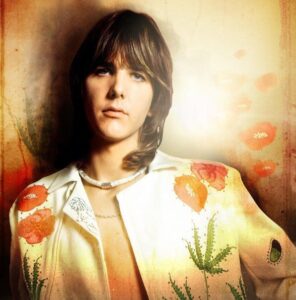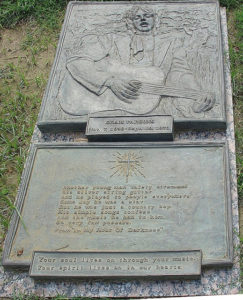#RIP #OTD in 1967 Ukrainian born artist Zinaida Serebriakova died after a brain hemorrhage in Paris aged 82. Cimetière de Liers, Sainte-Geneviève-des-Bois, France
 On this day in 1973, singer, songwriter, musician Gram Parsons died in Joshua Tree, California, at the age of 26 from an overdose of morphine and alcohol. Born Ingram Cecil Connor III on 5 November 1946, in Winter Haven, Florida. Parsons is best known for his work within the country music genre; he also popularized what he called “Cosmic American Music”, a hybrid of country, rhythm and blues, soul, folk, and rock. Besides recording as a solo artist, he also worked in several notable bands, including the International Submarine Band, The Byrds, and The Flying Burrito Brothers. His relatively short career is described by Allmusic as “enormously influential” for both country and rock, “blending the two genres to the point that they became indistinguishable from each other.” Parsons apparently developed an interest in country music while attending Harvard University. He founded the International Submarine Band in 1966, and after several months of delay their debut, Safe at Home, was released in 1968, by which time the group had disbanded. Parsons joined The Byrds in early 1968, and played a pivotal role in the making of the seminal Sweetheart of the Rodeo album. After leaving the group in late 1968, Parsons and fellow Byrd Chris Hillman formed The Flying Burrito Brothers in 1969, releasing their debut, The Gilded Palace of Sin, the same year. The album was well received but failed commercially. After a cross-country tour, they recorded Burrito Deluxe. Parsons was fired from the band before its release in early 1970. He soon signed with A&M Records, but after several unproductive sessions he canceled his intended solo debut in early 1971. Parsons moved to France, where he lived for a short period at Villa Nellcôte with his friend Keith Richards of The Rolling Stones. Returning to America, Parsons befriended Emmylou Harris, who assisted him on vocals for his first solo record, GP, released in 1973. Although it received enthusiastic reviews, the release failed to chart; his next album, Grievous Angel met with a similar reception, and peaked at number 195 on Billboard.
On this day in 1973, singer, songwriter, musician Gram Parsons died in Joshua Tree, California, at the age of 26 from an overdose of morphine and alcohol. Born Ingram Cecil Connor III on 5 November 1946, in Winter Haven, Florida. Parsons is best known for his work within the country music genre; he also popularized what he called “Cosmic American Music”, a hybrid of country, rhythm and blues, soul, folk, and rock. Besides recording as a solo artist, he also worked in several notable bands, including the International Submarine Band, The Byrds, and The Flying Burrito Brothers. His relatively short career is described by Allmusic as “enormously influential” for both country and rock, “blending the two genres to the point that they became indistinguishable from each other.” Parsons apparently developed an interest in country music while attending Harvard University. He founded the International Submarine Band in 1966, and after several months of delay their debut, Safe at Home, was released in 1968, by which time the group had disbanded. Parsons joined The Byrds in early 1968, and played a pivotal role in the making of the seminal Sweetheart of the Rodeo album. After leaving the group in late 1968, Parsons and fellow Byrd Chris Hillman formed The Flying Burrito Brothers in 1969, releasing their debut, The Gilded Palace of Sin, the same year. The album was well received but failed commercially. After a cross-country tour, they recorded Burrito Deluxe. Parsons was fired from the band before its release in early 1970. He soon signed with A&M Records, but after several unproductive sessions he canceled his intended solo debut in early 1971. Parsons moved to France, where he lived for a short period at Villa Nellcôte with his friend Keith Richards of The Rolling Stones. Returning to America, Parsons befriended Emmylou Harris, who assisted him on vocals for his first solo record, GP, released in 1973. Although it received enthusiastic reviews, the release failed to chart; his next album, Grievous Angel met with a similar reception, and peaked at number 195 on Billboard.
 The Final Footprint – Parsons’ body disappeared from the Los Angeles International Airport where it was being readied to be shipped to Louisiana for burial. Prior to his death, Parsons stated that he wanted his body cremated at Joshua Tree and his ashes spread over Cap Rock, a prominent natural feature there; however, Parsons’ stepfather, Robert Parson, arranged for a private ceremony back in New Orleans and neglected to invite any of his friends from the music industry. To fulfill Parsons’ funeral wishes, his friend Phil Kaufman stole his body from the airport and in a borrowed hearse drove it to Joshua Tree. Upon reaching the Cap Rock section of the park, they attempted to cremate Parsons’ corpse by pouring five gallons of gasoline into the open coffin and throwing a lit match inside. What resulted was an enormous fireball. The police gave chase but, as one account puts it, “were encumbered by sobriety,” and the men escaped. The two were arrested several days later. Since there was no law against stealing a dead body, they were only fined $750 for stealing the coffin and were not prosecuted for leaving 35 lbs of his charred remains in the desert.
The Final Footprint – Parsons’ body disappeared from the Los Angeles International Airport where it was being readied to be shipped to Louisiana for burial. Prior to his death, Parsons stated that he wanted his body cremated at Joshua Tree and his ashes spread over Cap Rock, a prominent natural feature there; however, Parsons’ stepfather, Robert Parson, arranged for a private ceremony back in New Orleans and neglected to invite any of his friends from the music industry. To fulfill Parsons’ funeral wishes, his friend Phil Kaufman stole his body from the airport and in a borrowed hearse drove it to Joshua Tree. Upon reaching the Cap Rock section of the park, they attempted to cremate Parsons’ corpse by pouring five gallons of gasoline into the open coffin and throwing a lit match inside. What resulted was an enormous fireball. The police gave chase but, as one account puts it, “were encumbered by sobriety,” and the men escaped. The two were arrested several days later. Since there was no law against stealing a dead body, they were only fined $750 for stealing the coffin and were not prosecuted for leaving 35 lbs of his charred remains in the desert.  Parsons body was eventually buried in Garden of Memories of Metairie, Louisiana. The site of Parsons’ cremation was marked by a small concrete slab and was presided over by a large rock flake known to rock climbers as The Gram Parsons Memorial Hand Traverse. The slab has since been removed by the U.S. National Park Service, and relocated to the Joshua Tree Inn. There is no monument at Cap Rock noting Parsons’ cremation at the site. Joshua Tree park guides are given the option to tell the story of Parsons’ cremation during tours, but there is no mention of the act in official maps or brochures. Fans regularly assemble simple rock structures and writings on the rock, which the park service sand blasts to remove from time to time.
Parsons body was eventually buried in Garden of Memories of Metairie, Louisiana. The site of Parsons’ cremation was marked by a small concrete slab and was presided over by a large rock flake known to rock climbers as The Gram Parsons Memorial Hand Traverse. The slab has since been removed by the U.S. National Park Service, and relocated to the Joshua Tree Inn. There is no monument at Cap Rock noting Parsons’ cremation at the site. Joshua Tree park guides are given the option to tell the story of Parsons’ cremation during tours, but there is no mention of the act in official maps or brochures. Fans regularly assemble simple rock structures and writings on the rock, which the park service sand blasts to remove from time to time.
Have you planned yours yet?
Follow us on twitter @RIPTFF

